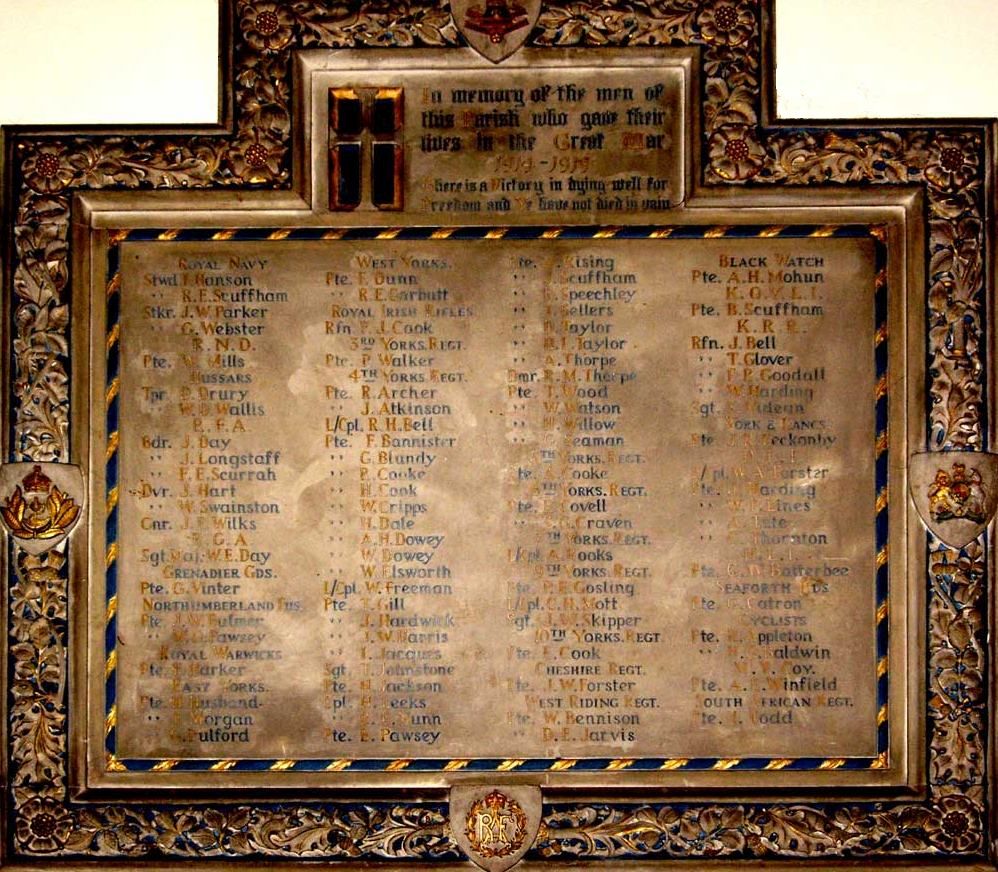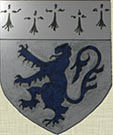
|

|
The following men of Skelton gave their lives in
the first world war.
Most are remembered by the war Memorials at Skelton and North
Skelton and a plaque in Skelton Church.
The names on the two Memorials do not make a comprehensive list of men who died in the War with connections to Skelton.
It seems that the criteria for inclusion was simply those who had been living in the village at the time of the outbreak of the War.
For instance, a plaque giving the names of Stanghow Lane School old boys who died in the War lists the names of 9 other men, who are omitted from the village Memorials.
There must have been several more casualties who had lived in Skelton at different times in the pre-War years and are commemorated elsewhere.
For example, the name of a Northumbrian Gardener working at Skelton Castle in 1914 appears on the Memorials. He may have lived in Skelton for a few
|
months, while someone who spent most of his life here and moved away is not included.
It has been estimated that for every man who died in the First War there were 4 or 5 others who were physically mutilated or suffered mentally.
Many of these would have had early deaths related to their War wounds and sadly they have been mostly forgotten, as official registration ended on the 11th November 1921.
As a young lad living in Skelton High Street just after the Second World War I could never forget a picture burnt on my mind of a New Skelton man who often walked past our house. His face was blue and he was constantly trembling
like a leaf from First War shell shock.
The village Memorials were planned and erected in the years immediately after the War, as were the Commonwealth War Graves, and men who died later were classed as survivors.
So the names on all the Nation's War Memorials are to some extent just a representation of the suffering and sacrifice made by that unfortunate generation.
There are those who would re-write History and say that Britain should never have taken part in the First War and that all this sacrifice was a waste.
But what Europe would be like today if the evil Kaiser had been allowed to drive the Western Front to the Channel and Atlantic ports cannot be imagined. A D Day would have been impossible.
In any case, ordinary village folk did not see the conflict in the light of international politics.
Our local lads had seen the German bombardment of the North East coast and believed that Britain was at risk of invasion. They went off to fight and die, often the most terrible of prolonged deaths, to protect their families and
country.
They had a patriotism that today many British people have lost. Left wingers even denigrate it.
If these lads could come back today though, and witness the crazy Socialist experiment with multi-culturalism that has changed the character of our Nation forever, where a British soldier can be butchered in broad daylight on our
own streets by invaders who hate us and many folk live in fear of similar atrocities and foreign take-over, they may well wonder why they bothered.
I like to think that G K Chesterton's words in his poem 'English Graves' still apply -
"They died to save their Country and they only saved the World."
I am trying to add some details here about their Families, the War situation in which they died, and the places where they are buried or commemorated.
Any information or corrections are welcome.
Royal Navy.
Stoker John William Parker. [31 May 1916]. Click to
see memorial.
|

Plaque in Skelton All Saints Church, High Street listing the war dead.
[Photograph by Edward Nicholl, The Yorkshire Regiment, First World War Remembrance website.
Here. ]
|

1914/15 STAR.
Authorised in 1918, the 1914/15 Star was awarded to those individuals
who saw service in France and Flanders from
23 November 1914 to 31 December 1915 and to those individuals who saw
service in any other operational theatre from 5 August 1914 to 31
December 1915.
BRITISH WAR MEDAL.
The British War Medal 1914-1920, authorised in 1919, was awarded to
eligible service personnel and civilians alike.
Qualification for the award varied slightly according to service.
The basic requirement for army personnel and civilians was that they
either entered a theatre of war, or rendered approved service overseas
between 5 August 1914 and 11 November 1918.
VICTORY MEDAL.
The Victory Medal 1914-1919 was also authorised in 1919 and was awarded
to all eligible personnel who served on the establishment of a unit in
an operational theatre.
|
6th Battalion, Yorkshire Regiment.
Pte Edward Covell. [7 Aug 1915.] Click to see memorial
Pte Sidney G Craven. [21 Aug 1915.] Click to see memorial
L/Cpl Wright Freeman. [10 Aug 1915.] Click to see memorial
L/Cpl Allan H Rooks. [14 Sep 1916.] Click to see memorial and photograph.
Pte John William Rudd. [28 Sep 1916.]Click to see memorial
7th Battalion, Yorkshire Regiment.
Pte T H Sellars, [17 Feb 1917.] Click to see memorial
9th Battalion, Yorkshire Regiment.
Pte P E Gosling [20 Sep 1917.] Click to see memorial
L/Cpl C H Mott. [15 Oct 1917.]Click to see memorial
Sgt J W Skipper.[9 Oct 1916.] Click to see memorial
Pte P Walker. [19 April 1917.]Click to see memorial
10th Battalion, Yorkshire Regiment.
Cpl Robert Henry Bell. [26 Oct 1917.] Click to see memorial
Pte E Cook. [29 Oct 1916.]Click to see memorial
13th Battalion, Yorkshire Regiment.
Private Harry Rudd. [21 Nov 1918.] Click to see memorial
1st/5th Battalion, Cheshire Regiment.
Pte Joseph William Forster. [8 Sep 1916.]Click to see memorial
Duke of Wellington's (West Riding Regiment).
Pte William Bennison. [15 April 1918.] Click to see memorial
Pte David E Jarvis. [29 Sep 1918.] Click to see memorial
|
|



